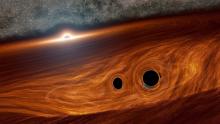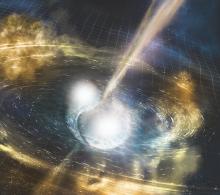Listen to today's episode of StarDate on the web the same day it airs in high-quality streaming audio without any extra ads or announcements. Choose a $8 one-month pass, or listen every day for a year for just $30.
You are here
Pulsar Timing
If you’re cruising through space, stay away from pulsars — they’re nasty. They produce deadly radiation, and their gravity rips apart anything that gets close. From many light-years away, though, pulsars could be handy.
A pulsar is the crushed core of a once-mighty star. It’s heavier than the Sun, but only as big as a city. It spins rapidly, beaming energy into space like a cosmic lighthouse. We see these beams as pulses of radio waves or other forms of energy.
Young pulsars rotate dozens to hundreds of times per second. Their pulses are as regular as clockwork. And astronomers are using that precise timing to look for gravitational waves — “jiggles” in space-time caused by the motions of heavy objects. In particular, they’re looking for waves produced by the mergers of supermassive black holes.
As the waves move through space, they cause space itself to shrink and expand by tiny amounts. That changes the distances between objects by a tiny amount.
And that’s what astronomers are looking for. They’re using arrays of radio telescopes to watch many pulsars. By changing the distance between Earth and the pulsars, gravitational waves would change the timing of their “pulses” of energy.
The change is tiny. And so far, astronomers haven’t detected any gravitational waves this way. But they’re adding more telescopes and better detectors to the effort — using the “pulses” of dead stars to hunt for giant black holes.
Script by Damond Benningfield






